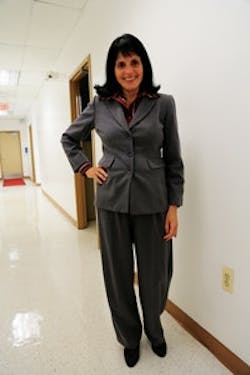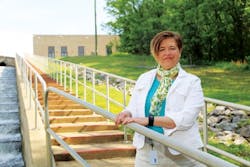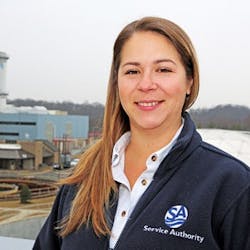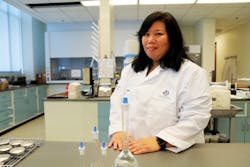About the author: Kipp Hanley is copywriter for the Prince William County Service Authority. Hanley can be reached at [email protected] or703.335.8914.
A diverse set of talented women at the Prince William County Service Authority in Virginia are leading the charge of protecting the health of the public and the environment.
Evelyn Mahieu, Shannon Spence, Rachel Carlson, Jojean Bolton and Maureen O’Shaughnessy are thriving in their respective roles at the service authority’s H.L. Mooney Advanced Water Reclamation Facility (AWRF). This is due to their skill, professionalism and the cohesive environment they have worked diligently to create. This welcoming environment starts at the top.
Evelyn Mahieu, Division Director, Environmental Services & Water Reclamation (ESWR)
A native of Puerto Rico and the first in her family to go to college, Evelyn Mahieu has helped operations at the wastewater plant flow smoothly, with no permit violations since she began as head of the division in 2011. Mahieu’s engaging and direct leadership style has impressed Shannon Spence, deputy director for ESWR.
“We are all about team building here, breaking down silos between Mooney and the rest of the service authority,” Spence said of Mahieu and her staff. “You can really tell that with the way our leadership functions at the plant.”
Mahieu thinks that her self confidence and positive attitude have been a driving force in her career.
“I have faced the glass ceiling before, and how I dealt with it was that I did my very best every day,” Mahieu said. “I never considered complaining about it or letting it get me down.”
Shannon Spence, ESWR Division Deputy Director
As one of the few female electrical workers for the International Brotherhood for Electrical Workers in New York City in the 1980s, Spence experienced many challenges.
Ultimately, she decided to embark on a career in engineering to better her life and that of her family. In 1996, she earned a civil engineering degree at The Cooper Union for Advancement of Science and Art in New York City at age 34. Spence then worked for Malcolm Pirnie and Arcadis as a consultant before starting at the service authority this winter.
It has been a great marriage so far, according to Spence.
“The sort of culture here, where all these different types of women feel nurtured and empowered, said something to me about this organization,” Spence said.
Rachel Carlson, Operations Plant Manager
Any reservations about Rachel Carlson’s ability to earn respect from her 24 employees at the H.L. Mooney AWRF were quickly dispelled once they saw her experience in action.
“Some of the guys that had worked here for a long time saw a lot of operators come and go,” Carlson, a 35-year-old Prince William County native, said. “Once I demonstrated the knowledge that I had, though, I don’t think it took long for them to accept me.”
Carlson served as a plant manager at Virginia American Water’s local wastewater plant (formerly known as Dale Services Corp.) where she helped create the utility’s first in-house laboratory. In 2013, she was hired into her current position at the service authority.
“She is approachable and will always make herself available to discuss issues or problems you may have in the plant,” said James Nicely, a solids specialist who has worked at the service authority for nearly 30 years. “She listens to your ideas and is always willing to lend a hand if you need help, no matter how dirty the job is.”
JoJean Bolton, Laboratory Manager
Working as a scientist in the drinking water and wastewater field has only heightened Jojean Bolton’s appreciation for serving as a steward of the natural world.
“Though I have been in the water business for more than 20 years, I am still surprised at how many people take clean water for granted,” said Bolton, who was the laboratory manager at Fairfax Water before joining the service authority.
Bolton said she has not experienced the prejudice that some of her former female colleagues have in science, technology, engineering and mathematics-related fields. This is due, in large part, to the culture she has experienced at the service authority. In fact, Bolton is among 10 women who work in the 16-person laboratory department.
“I can attest to the scarcity of women scientists and engineers in years past, especially in leadership positions,” Bolton said. “When I started at the Service Authority, I was pleased to find women in all departments and at all levels within the company.”
Maureen O’Shaughnessy, Process Engineer Maureen
O’Shaughnessy did not experience many obstacles as she rose through the ranks in the engineering world during the 1990s. The Canadian native believes this may be due to her mentor Dr. Michael Yu, who was the lead process engineer and wastewater plant designer at her first job after college.
“With Dr. Yu, I worked on many different projects and benefited from his review and judgement and his philosophy of continuous learning,” O’Shaughnessy said.
O’Shaughnessy believes there are more opportunities for women to shine in her profession than when she began her career. For proof of that, all she has to do is take a look at the composition of the service authority’s staff.
“The longer I stay in the engineering field, the more diverse it is,” O’Shaughnessy said. “So, I think the future looks promising for the entire industry.”




